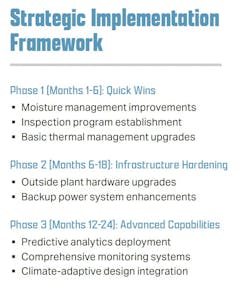Top 6 Weatherproofing Strategies for Network Resilience
Key Highlights
- Extreme weather now poses a constant, costly threat to broadband networks, making climate resilience a business priority.
- Operators can reduce risk through advanced materials, proactive maintenance, and data-driven storm preparation.
- Predictive analytics and climate modeling are shifting network resilience from reactive repair to proactive design.
Extreme weather has evolved from an occasional operational challenge to a persistent, escalating threat to network infrastructure, and for broadband service providers, the stakes are high. Each event can trigger weeks of service restoration efforts and millions in unplanned repair costs, making weatherproofing a good engineering practice as well as a business imperative.
Fall is the perfect time to evaluate your readiness, implement proactive measures and ensure crews are equipped to respond quickly when the next storm hits. Here are six evidence-based approaches every network operator should prioritize:
1. Harden Outside Plant Hardware with Advanced Materials
Traditional materials are failing under increasingly severe conditions. Modern composite alternatives offer superior performance and life cycle economics.
Best Practice: Upgrade poles, cabinets, and enclosures with materials engineered for extreme environments. Fiber-reinforced polymer (FRP) poles demonstrate exceptional durability with published projections commonly citing 80-year design life for FRP versus 30–50 years for treated wood. They resist corrosion, rot and insect damage while maintaining structural integrity under hurricane-force winds.
Technical Specifications:
- Cabinets: NEMA 4X or IP65+ ratings minimum for outdoor applications, providing protection against wind-driven rain, complete dust ingress and corrosion.
- Enhanced environmental sealing for coastal and industrial environments.
- Temperature-rated enclosures designed for regional climate extremes.
Implementation Strategy: Begin with the highest-risk and critical service areas. Evaluate the total cost of ownership, including reduced maintenance and replacement cycles.
2. Implement Comprehensive Moisture Management
Water ingress is among the most significant causes of post-storm service degradation, making moisture management one of the highest-impact, lowest-cost improvements available.
Multi-Layer Approach:
- Cable Selection: Deploy gel-filled or dry-blocked cables to prevent water migration along cable runs.
- Splice Protection: Apply advanced heat-shrink or cold-applied sealing systems at all connection points.
- Preventive Maintenance: Reseal handholes, vaults, and cabinet penetrations annually before storm season.
- Drainage Systems: Install proper conduit drainage with flood-resistant materials for buried assets.
Cost-Benefit Analysis: Preventive moisture management represents one of the highest ROI activities in network hardening, as small investments in resealing can prevent major emergency restoration costs.
3. Engineer for Thermal Extremes
Electronics face dual threats from overheating and freezing, with temperature-related failures following predictable patterns.
The Temperature-Reliability Relationship: While the "10°C increase halves component life" rule is widely cited, it's actually a simplified approximation that applies to specific failure mechanisms under certain conditions. The reality is more nuanced, but the fundamental principle remains: thermal management is critical for equipment longevity.
Climate-Adaptive Solutions:
- Hot Climate Protection: Install passive cooling systems, heat exchangers, or thermostatically controlled active cooling.
- Cold Climate Protection: Deploy thermostatically controlled heaters and insulation systems.
- Temperature Monitoring: Implement continuous monitoring with automated alerts and protective shutdowns.
Regional Considerations: Customize thermal management strategies based on local climate data and projected changes.
4. Design Resilient Backup Power Systems
When grid power fails, autonomous operation capability determines service continuity and customer retention.
Strategic Value: Backup power systems provide operational independence during grid disruptions, allowing networks to continue serving customers when they may need connectivity most. Power outages often coincide with severe weather events, creating situations where communication services become essential for safety, coordination and recovery efforts.
Planning Considerations:
- Load Assessment: Evaluate which systems require continuous operation versus those that can be temporarily suspended.
- Duration Planning: Consider typical outage patterns in your service area and the time required to implement alternative solutions.
- Capacity Sizing: Balance power requirements against practical constraints such as space, weight, and maintenance accessibility.
- Fuel Logistics: For generator-based systems, plan fuel storage and resupply logistics appropriate to your operational environment.
Advanced Considerations:
- Integrate renewable energy sources where feasible.
- Consider distributed backup systems for improved resilience.
- Plan for extended outages (7+ days) in extreme scenarios with portable generation capabilities.
5. Establish Disciplined Inspection and Maintenance Programs
Resilience begins with systematic maintenance that identifies and addresses vulnerabilities before they become failures.
Inspection Protocol:
- Seasonal Scheduling: Conduct thorough inspections before and after peak weather seasons.
- Critical Elements: Focus on seals, structural mounts, guy wires, drainage systems and thermal management.
- Documentation: Track findings in centralized systems to identify recurring problem locations.
- Predictive Maintenance: Use historical data to schedule proactive replacements.
Resource Optimization: Train existing field personnel on inspection protocols to minimize additional staffing requirements while improving asset knowledge.
6. Deploy Predictive Analytics and Risk Assessment
Advanced analytics transform reactive maintenance into proactive risk management, optimizing both capital deployment and operational response.
Technology Integration:
- Climate Modeling: Overlay network maps with floodplain, wildfire risk, wind zone and projected climate change data.
- Asset Monitoring: Deploy sensors for continuous monitoring of critical infrastructure health.
- Predictive Deployment: Use weather forecasting to pre-position crews, spare parts and backup power ahead of storm tracks.
- Investment Prioritization: Use risk modeling to optimize hardening investments across the network.
Implementation Phases:
- Data Collection: Aggregate existing asset, risk and historical failure data.
- Model Development: Build predictive models specific to local conditions and infrastructure.
- Decision Support: Create dashboards and automated alerts for operational teams.
- Continuous Improvement: Refine models based on actual events and outcomes.
Looking Ahead: Climate-Adaptive Network Design
The future of network resilience lies in proactive, data-driven approaches that anticipate rather than simply react to extreme weather. Advanced climate modeling can now simulate specific storm impacts on individual network sites with remarkable accuracy. Combined with automated asset monitoring and AI-driven analytics, this capability enables operators to harden infrastructure and reroute traffic days before severe weather arrives.
Stay connected with ISE Magazine
Subscribe to our newsletters and magazine for the latest telecom insights, explore the current issue for in-depth features and strategies, and register for upcoming webinars to learn directly from industry leaders.
About the Author
Hayden Beeson
Editor, ISE Magazine
Hayden Beeson is a writer and editor who currently serves as the Editor of ISE Magazine at Endeavor Business Media. He previously held editorial roles with Lightwave, Broadband Technology Report, LEDs Magazine and Architectural SSL.


